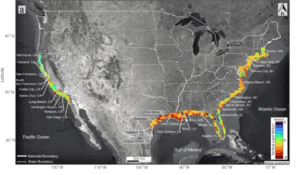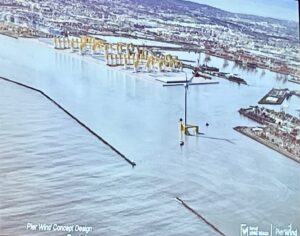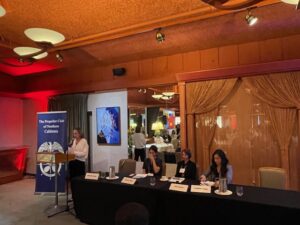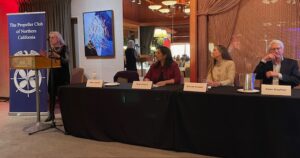By Stas Margaronis, RBTUS
Desalination and waste water treatment plants can replenish groundwater and slow the sinking of U.S. coastal cities and ports, according to Randy Truby, President, RL Truby & Associates and a former President of the International Desalination Association.
Truby was the keynote speaker at the Storms, Flooding & Sea level Defense 2024 Conference produced by the Propeller Club of Northern California and the Society of American Military Engineers that took place on November 12, 2024.
DEFENDING SINKING CITIES & PORTS
Truby spoke on the topic: “Desalination Strategies to Replenish Water Tables and Reduce Coastal Subsidence”
Truby cited an article published in the science magazine ‘NATURE’ which describes the combined impact of global sea level rise (projected 0.25-0.3 meters by 2050) and the sinking of coastal land areas (coastal subsidence).
The Virginia Tech authors of the report expressed concern that the combination of these forces will accelerate the impact of Sea Level Rise as coastal cities and communities are sinking and as sea levels rise.
The study’s authors argued for more wastewater treatment and ocean desalination to pump water back into water tables so as to slow the impact of subsidence that is sinking U.S. coastal cities and ports:
“The sea level along the US coastlines is projected to rise by 0.25–0.3 m by 2050, increasing the probability of more destructive flooding and inundation in major cities. However, these impacts may be exacerbated by coastal subsidence—the sinking of coastal land areas—a factor that is often underrepresented in coastal-management policies and long-term urban planning. In this study, we combine high-resolution vertical land motion (that is, raising or lowering of land) and elevation datasets with projections of sea-level rise to quantify the potential inundated areas in 32 major US coastal cities. Here we show that, even when considering the current coastal-defence structures, further land area of between 1,006 and 1,389 km2 is threatened by relative sea-level rise by 2050, posing a threat to a population of 55,000–273,000 people and 31,000–171,000 properties. Our analysis shows that not accounting for spatially variable land subsidence within the cities may lead to inaccurate projections of expected exposure. These potential consequences show the scale of the adaptation challenge, which is not appreciated in most US coastal cities.”
That study can be found here: https://www.nature.com/articles/s41586-024-07038-3
Truby noted the threat “may not be appreciated by planners and stakeholders.”
The study focused on 32 coastal cities and ports and found the sinking impact greatest among cities and ports adjoining the Gulf of Mexico.
One in 50 people living in two dozen coastal cities in the United States could experience significant flooding by 2050, according to the Virginia Tech-led research team. The study provides a new comprehensive look at the flood risks for 32 cities on three coasts by 2050. (Image courtesy of Leonard Ohenhen)
Source: “Disappearing cities on US coasts”
Truby went on to explain: “On the Pacific Coast well water has provided drinking water to large population centers. Both Orange and parts of San Diego County rely on well water. During drought cycles the wells would subside (draw down) and seawater would intrude adding enough sodium chloride to remove the water from “potable” status. The Orange County Water District (OCWD) developed a Ground Water Replenishment (GWR) strategy to recycle wastewater and inject it into the wells thus creating a barrier to seawater intrusion and combating subsidence. This GWR approach has been highly successful and has been employed globally with great success.”
Truby said that on the Atlantic Coast “well water is relied upon to an even a greater extent than on the Pacific Coast. Florida processes and distributes hundreds of millions of gallons of water per day from wells. After years of utilizing these wells, incidents of “sink holes,” seawater intrusion and subsidence have been increasing. GWR strategies to combat seawater intrusion are being used where feasible. In many coastal locations seawater desalination is utilized to provide potable water and thus reduce the reliance on groundwater and reduce subsidence. The 25 MGD (Million Gallons/ Day) Tampa Bay Desalination System was the first large seawater installation in the USA.”
Truby summarized the possibilities of desalination and waste water treatment as strategies to increase the global fresh water supply and help reduce subsidence of coastal cities:
- Desalination technology has played a role in combating sea water rise and subsidence
- Desalination growth-8%/year innovations continue to reduce energy consumption
- Innovations will expand the future applications and role of desalination technology benefiting humanity
Other conference panels included:
PORT OF LONG BEACH ‘PIER WIND’ OFFHORE WIND PORT PROJECT PRESENTATION
At the conference, Suzanne Plezia, Chief Harbor Engineer, Port of Long Beach outlined plans for the offshore wind port, Pier Wind.
Plezia was introduced by Sarp Ersoylu, Burns & McDonnell.
The Port of Long Beach projects that it will begin construction on its 400 acre ‘Pier Wind’ offshore wind port in 2027 which is projected to cost $4.7 billion.
Citing the California AB 525 Port Readiness Plan, Plezia noted that the deployment of floating offshore wind turbines and farms off the California coast will require:
- A multi-port strategy
- Staging and integration sites are the most critical
- Only a few ports are suitable for staging and integration
- Port of Long Beach is one of them
The big question mark is whether opposition from the incoming Trump Administration will blunt financing of the project.
Other panels and presentations included:
REGIONAL SHORELINE ADAPTATION PLANNING
Summer Bundy, Climate Change Adaptation & Coastal Resilience Specialist was the moderator on the Regional Shoreline Adaptation Planning Panel that included:
Jessica Fain, Director of Planning, Bay Conservation and Development Commission (BCDC)
Gail Payne, Project Manager, City of Alameda
Colleen Liang, Director of Environmental Programs and Planning, Port of Oakland
BCDC’s Jessica Fain explained that BCDC has been granted sweeping new powers to require sea level adaptation plans by San Francisco Bay Area communities. She pointed out that the cost of creating resilience in the San Francisco Bay is projected at $110 billion for the “Estimated cost of sea level rise adaptation through 2050 (in Year of Expenditure dollars).”
This includes:
- $52 billion: Estimated cost for known or planned projects
- $54 billion: Estimated placeholder cost for areas with adaptation needs
- $3 billion: Estimated additional sediment management needs
Fain said the cost of inaction was $230 billion in the “Estimated value of a subset of assets at risk through 2050. The cost of inaction is far higher than the cost of adaptation. We stand to lose much more if we do not act.”
Fain cited new legislation to support sea level rise adaptation (SB 272, 2023) which mandates local jurisdictions to develop “San Francisco Bay subregional resiliency plans” and for BCDC to develop guidelines that those plans must follow…”
FLOOD & SEA LEVEL RISE IMPACTS & RESPONSES BY BAY AREA COMMUNITY ORGANIZATIONS
Moderator: Sarah Atkinson, Hazard Resilience Senior Policy Manager, SPUR (San Francisco Bay Area Planning and Urban Research) introduced the panel that included:
Carly Finkle, Senior Policy Manager, Canal Alliance
Osvaldo Macias, Environmental Justice Fellow, Nuestra Casa
Zoe Siegel, Senior Director of Climate Resilience, Greenbelt Alliance
NATURE BASED SOLUTIONS FOR ADAPTATION AND RESILIENCE
Ellen Johnck, Ellen Johnck Consulting introduced the Nature-Based Solutions panel that included:
Tami Church, Environmental Planning Section Chief, U.S. Army Corps of Engineers, San Francisco District
Brenda Goeden, Sediment Program Manager, Bay Conservation and Development Commission
Peter Dreyfuss, Managing Director, Watermaster North America







